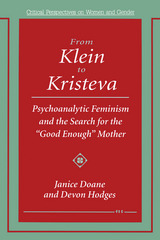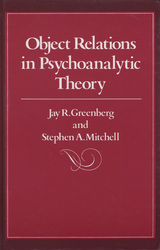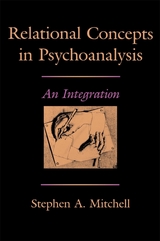

Object Relations in Psychoanalytic Theory provides a masterful overview of the central issue concerning psychoanalysts today: finding a way to deal in theoretical terms with the importance of the patient's relationships with other people. Just as disturbed and distorted relationships lie at the core of the patient's distress, so too does the relation between analyst and patient play a key role in the analytic process. All psychoanalytic theories recognize the clinical centrality of “object relations,” but much else about the concept is in dispute. In their ground-breaking exercise in comparative psychoanalysis, the authors offer a new way to understand the dramatic and confusing proliferation of approaches to object relations. The result is major clarification of the history of psychoanalysis and a reliable guide to the fundamental issues that unite and divide the field.
Greenberg and Mitchell, both psychoanalysts in private practice in New York, locate much of the variation in the concept of object relations between two deeply divergent models of psychoanalysis: Freud's model, in which relations with others are determined by the individual's need to satisfy primary instinctual drives, and an alternative model, in which relationships are taken as primary. The authors then diagnose the history of disagreement about object relations as a product of competition between these disparate paradigms. Within this framework, Sullivan's interpersonal psychiatry and the British tradition of object relations theory, led by Klein, Fairbairn, Winnicott, and Guntrip, are shown to be united by their rejection of significant aspects of Freud's drive theory. In contrast, the American ego psychology of Hartmann, Jacobson, and Kernberg appears as an effort to enlarge the classical drive theory to accommodate information derived from the study of object relations.
Object Relations in Psychoanalytic Theory offers a conceptual map of the most difficult terrain in psychoanalysis and a history of its most complex disputes. In exploring the counterpoint between different psychoanalytic schools and traditions, it provides a synthetic perspective that is a major contribution to the advance of psychoanalytic thought.

There are more psychoanalytic theories today than anyone knows what to do with, and the heterogeneity and complexity of the entire body of psychoanalytic though have become staggering. In Relational Concepts in Psychoanalysis, Stephen A. Mitchell weaves strands from the principal relational-model traditions (interpersonal psychoanalysis, British school object-relations theories, self psychology, and existential psychoanalysis) into a comprehensive approach to many of the knottiest problems and controversies in theoretical and clinical psychoanalysis.
Mitchell’s earlier book, Object Relations in Psychoanalytic Theory, co-authored with Jay Greenberg, set the stage for this current integration by providing a broad comparative analysis of important thinking on the nature of human relationships. In that classic study Greenberg and Mitchell distinguished between two basic paradigms: the drive model, in which relations with others are generated and shaped by the need for drive gratifications, and various relational models, in which relations themselves are taken as primary and irreducible. In Relational Concepts in Psychoanalysis, Mitchell argues that the drive model has since outlived its usefulness. The relational model, on the other hand, has been developed piecemeal by different authors who rarely acknowledge and explore the commonality of their assumptions or the rich complementarity of their perspectives.
In this bold effort at integrative theorizing, Mitchell draws together major lines of relational-model traditions into a unified framework for psychoanalytic thought, more economical than the anachronistic drive model and more inclusive than any of the singular relational approaches to the core significance of sexuality, the impact of early experience, the relation of the past to the present, the interpenetration of illusion and actuality, the centrality of the will, the repetition of painful experience, the nature of analytic situation, and the process of analytic change. As such, his book will be required reading for psychoanalytic scholars, practitioners, candidates in psychoanalysis, and students in the field.
READERS
Browse our collection.
PUBLISHERS
See BiblioVault's publisher services.
STUDENT SERVICES
Files for college accessibility offices.
UChicago Accessibility Resources
home | accessibility | search | about | contact us
BiblioVault ® 2001 - 2024
The University of Chicago Press









